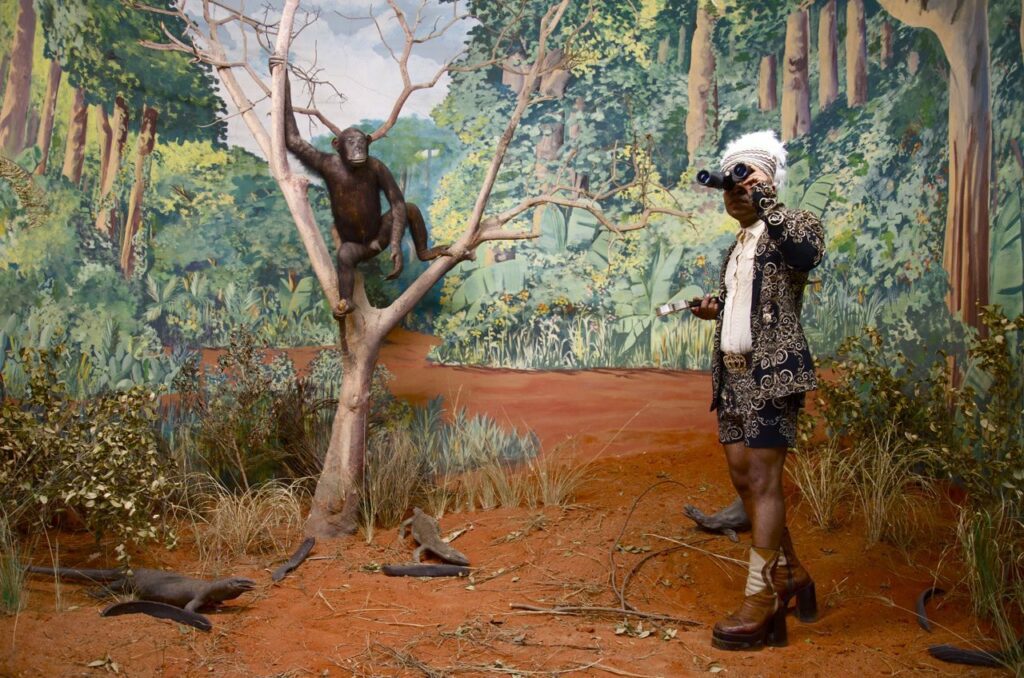Goodman Gallery, Cape Town, South Africa
07 Oct 2017 - 28 Oct 2017

Kiluanji Kia Henda, The Last Journey of the Dictator Mussunda N'zombo Before the Great Extinction (Act II), 2017, Courtesy Goodman Gallery.
Since parallel lines only meet at infinity, so do colonialism and populism meet in neo-colonialism. Both forge artificial images of nature, the hiding place of the state’s violence – Kiluanji Kia Henda and Lucas Parente
In the Days of a Dark Safari marks Kiluanji Kia Henda’s first solo exhibition with Goodman Gallery. The exhibition comes at a significant moment in artist’s career as the recipient of the 2017 Frieze Artist Award – making Kia Henda the rst African artist to receive the award.
The exhibition critiques the fallacy inherent in the opposing discourses of colonial-era ‘noble savagery’ as encapsulated in Joseph Conrad’s Heart of Darkness (that African nature is ‘something monstrous and free’) ; and post-colonial populism which espouses the ideal of a natural world in Africa as a Paradise Lost.
Kia Henda describes African populism in the following terms: ‘This is the discourse of those looking from the inside, claiming that the expulsion from paradise is the fault of those who came from the outside. They use the claim to their advantage and to hide the destruction by people who colonise themselves, pinning the blame for Africa ́s failures on an external phantom.’
In Kia Henda’s practice, the artist aims to demystify both the ideas of Darkness and the Immaculate Paradise. The exhibition features recent photographs from two series: In the Days of a Dark Safari and The Last Journey of the Dictator Mussunda N’zombo Before the Great Extinction (in 5 acts), as well as a film, titled Havemos de Voltar (We Shall Return).
In the Days of a Dark Safari combines historical research with artistic photography to reflect the ideals projected onto the image of a stuffed giant sable antilope (Palanca). In this series, the artist attempts to unveil a ctitious element of ‘of cial history’, showing that there are two sides to every narrative, but he is particularly critical of the position of the colonialist who ‘collects information in the forest and lays it out in museum display cases’. For Kia Henda, ‘the effort to create a Museum of Natural History is a process similar to the creation of hostile narratives from the perspective of the foreigner who colonises by maintaining distance, consigning an entire continent to a Place of Darkness.’
The Last Journey of the dictator Mussunda N’Zombo Before the Great Extinction portrays the end of dictatorships in Africa, based on the persona of former president Mobutu Sese Seko, who is considered the archetype of African dictators. In the photographic series, the dead corpse of power undergoes taxidermy while animal-objects come to life. The series also plays with depicting safaris through ‘African scenery’.
Kia Henda (b. Luanda, Angola) lives and works between Luanda and Lisbon. Practicing in the fields of photography, video, and performance, the arist employs a surprising sense of humour to unpack perceptions of postcolonialism and modernism in Africa. His conceptual edge has been sharpened by immersing himself in music, avant-garde theatre, and collaborating with a collective of emerging artists in Luanda’s art scene.
Kia Henda’s most recent solo exhibition was at ISCP New York, 2017. His work has been exhibited at institutions including Tate Liverpool, 2017; SCAD Museum, Savannah, 2016; Centre Georges Pompidou, Paris, 2016; National Museum of African Art – Smithsonian Institution, Washington, D.C., 2015; Tamayo Museum, Mexico, 2012; and Arnol ni, Bristol, 2012. He has participated in the 2015 Triennial: Surround Audience, New Museum, New York; Dakar Biennale, 2014; Bienal de São Paulo, 2007; Venice Biennale, 2007, and the Luanda Triennale, 2007.
He is the winner of 2017 Frieze Artist Award and the 2012 National Prize of Art and Culture, awarded by the Ministry of Culture, Luanda.